A Study on Consumer Behavior and Samsung Smartphones Purchase
VerifiedAdded on 2022/10/15
|33
|7372
|435
Report
AI Summary
This report investigates the factors influencing consumer behavior toward Samsung smartphones, aiming to identify key drivers for purchase decisions. The study examines the impact of appearance, price, security features, and camera functions on consumer choices. Through a survey of 60 respondents aged 20-40, the research employs frequency analysis and cross-tabulations to analyze data. Findings reveal that price is a significant factor, with a majority willing to spend over $500 on a smartphone. The report also highlights the importance of word-of-mouth marketing and the competitive landscape, particularly Apple's strong market presence. Based on these results, the report provides strategic recommendations for Samsung to enhance its marketing efforts and product development to better meet consumer needs and maintain its competitive edge in the smartphone market. The report concludes with actionable recommendations for Samsung to improve its market position by focusing on key consumer preferences.
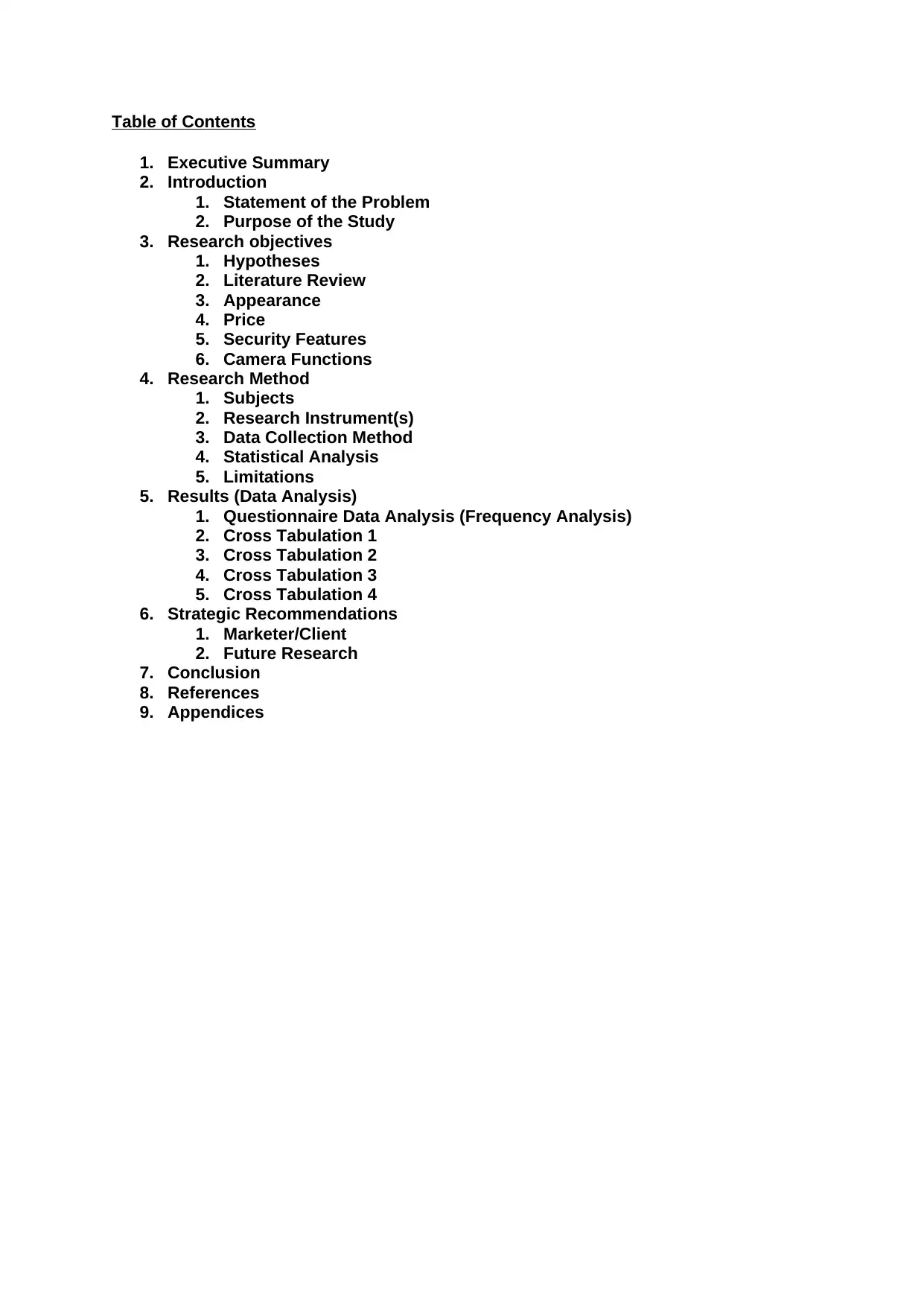
Table of Contents
1. Executive Summary
2. Introduction
1. Statement of the Problem
2. Purpose of the Study
3. Research objectives
1. Hypotheses
2. Literature Review
3. Appearance
4. Price
5. Security Features
6. Camera Functions
4. Research Method
1. Subjects
2. Research Instrument(s)
3. Data Collection Method
4. Statistical Analysis
5. Limitations
5. Results (Data Analysis)
1. Questionnaire Data Analysis (Frequency Analysis)
2. Cross Tabulation 1
3. Cross Tabulation 2
4. Cross Tabulation 3
5. Cross Tabulation 4
6. Strategic Recommendations
1. Marketer/Client
2. Future Research
7. Conclusion
8. References
9. Appendices
1. Executive Summary
2. Introduction
1. Statement of the Problem
2. Purpose of the Study
3. Research objectives
1. Hypotheses
2. Literature Review
3. Appearance
4. Price
5. Security Features
6. Camera Functions
4. Research Method
1. Subjects
2. Research Instrument(s)
3. Data Collection Method
4. Statistical Analysis
5. Limitations
5. Results (Data Analysis)
1. Questionnaire Data Analysis (Frequency Analysis)
2. Cross Tabulation 1
3. Cross Tabulation 2
4. Cross Tabulation 3
5. Cross Tabulation 4
6. Strategic Recommendations
1. Marketer/Client
2. Future Research
7. Conclusion
8. References
9. Appendices
Paraphrase This Document
Need a fresh take? Get an instant paraphrase of this document with our AI Paraphraser
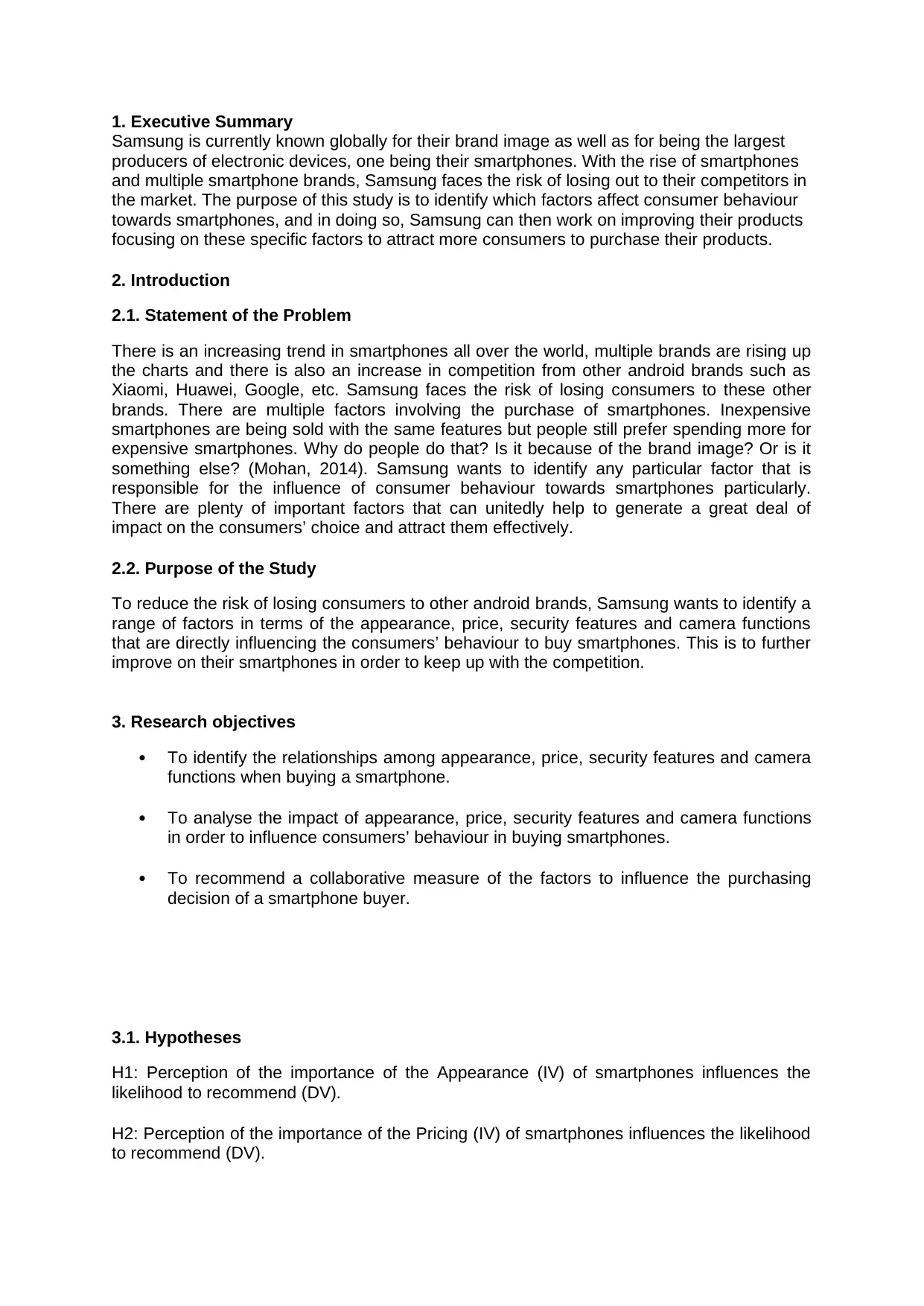
1. Executive Summary
Samsung is currently known globally for their brand image as well as for being the largest
producers of electronic devices, one being their smartphones. With the rise of smartphones
and multiple smartphone brands, Samsung faces the risk of losing out to their competitors in
the market. The purpose of this study is to identify which factors affect consumer behaviour
towards smartphones, and in doing so, Samsung can then work on improving their products
focusing on these specific factors to attract more consumers to purchase their products.
2. Introduction
2.1. Statement of the Problem
There is an increasing trend in smartphones all over the world, multiple brands are rising up
the charts and there is also an increase in competition from other android brands such as
Xiaomi, Huawei, Google, etc. Samsung faces the risk of losing consumers to these other
brands. There are multiple factors involving the purchase of smartphones. Inexpensive
smartphones are being sold with the same features but people still prefer spending more for
expensive smartphones. Why do people do that? Is it because of the brand image? Or is it
something else? (Mohan, 2014). Samsung wants to identify any particular factor that is
responsible for the influence of consumer behaviour towards smartphones particularly.
There are plenty of important factors that can unitedly help to generate a great deal of
impact on the consumers’ choice and attract them effectively.
2.2. Purpose of the Study
To reduce the risk of losing consumers to other android brands, Samsung wants to identify a
range of factors in terms of the appearance, price, security features and camera functions
that are directly influencing the consumers’ behaviour to buy smartphones. This is to further
improve on their smartphones in order to keep up with the competition.
3. Research objectives
To identify the relationships among appearance, price, security features and camera
functions when buying a smartphone.
To analyse the impact of appearance, price, security features and camera functions
in order to influence consumers’ behaviour in buying smartphones.
To recommend a collaborative measure of the factors to influence the purchasing
decision of a smartphone buyer.
3.1. Hypotheses
H1: Perception of the importance of the Appearance (IV) of smartphones influences the
likelihood to recommend (DV).
H2: Perception of the importance of the Pricing (IV) of smartphones influences the likelihood
to recommend (DV).
Samsung is currently known globally for their brand image as well as for being the largest
producers of electronic devices, one being their smartphones. With the rise of smartphones
and multiple smartphone brands, Samsung faces the risk of losing out to their competitors in
the market. The purpose of this study is to identify which factors affect consumer behaviour
towards smartphones, and in doing so, Samsung can then work on improving their products
focusing on these specific factors to attract more consumers to purchase their products.
2. Introduction
2.1. Statement of the Problem
There is an increasing trend in smartphones all over the world, multiple brands are rising up
the charts and there is also an increase in competition from other android brands such as
Xiaomi, Huawei, Google, etc. Samsung faces the risk of losing consumers to these other
brands. There are multiple factors involving the purchase of smartphones. Inexpensive
smartphones are being sold with the same features but people still prefer spending more for
expensive smartphones. Why do people do that? Is it because of the brand image? Or is it
something else? (Mohan, 2014). Samsung wants to identify any particular factor that is
responsible for the influence of consumer behaviour towards smartphones particularly.
There are plenty of important factors that can unitedly help to generate a great deal of
impact on the consumers’ choice and attract them effectively.
2.2. Purpose of the Study
To reduce the risk of losing consumers to other android brands, Samsung wants to identify a
range of factors in terms of the appearance, price, security features and camera functions
that are directly influencing the consumers’ behaviour to buy smartphones. This is to further
improve on their smartphones in order to keep up with the competition.
3. Research objectives
To identify the relationships among appearance, price, security features and camera
functions when buying a smartphone.
To analyse the impact of appearance, price, security features and camera functions
in order to influence consumers’ behaviour in buying smartphones.
To recommend a collaborative measure of the factors to influence the purchasing
decision of a smartphone buyer.
3.1. Hypotheses
H1: Perception of the importance of the Appearance (IV) of smartphones influences the
likelihood to recommend (DV).
H2: Perception of the importance of the Pricing (IV) of smartphones influences the likelihood
to recommend (DV).
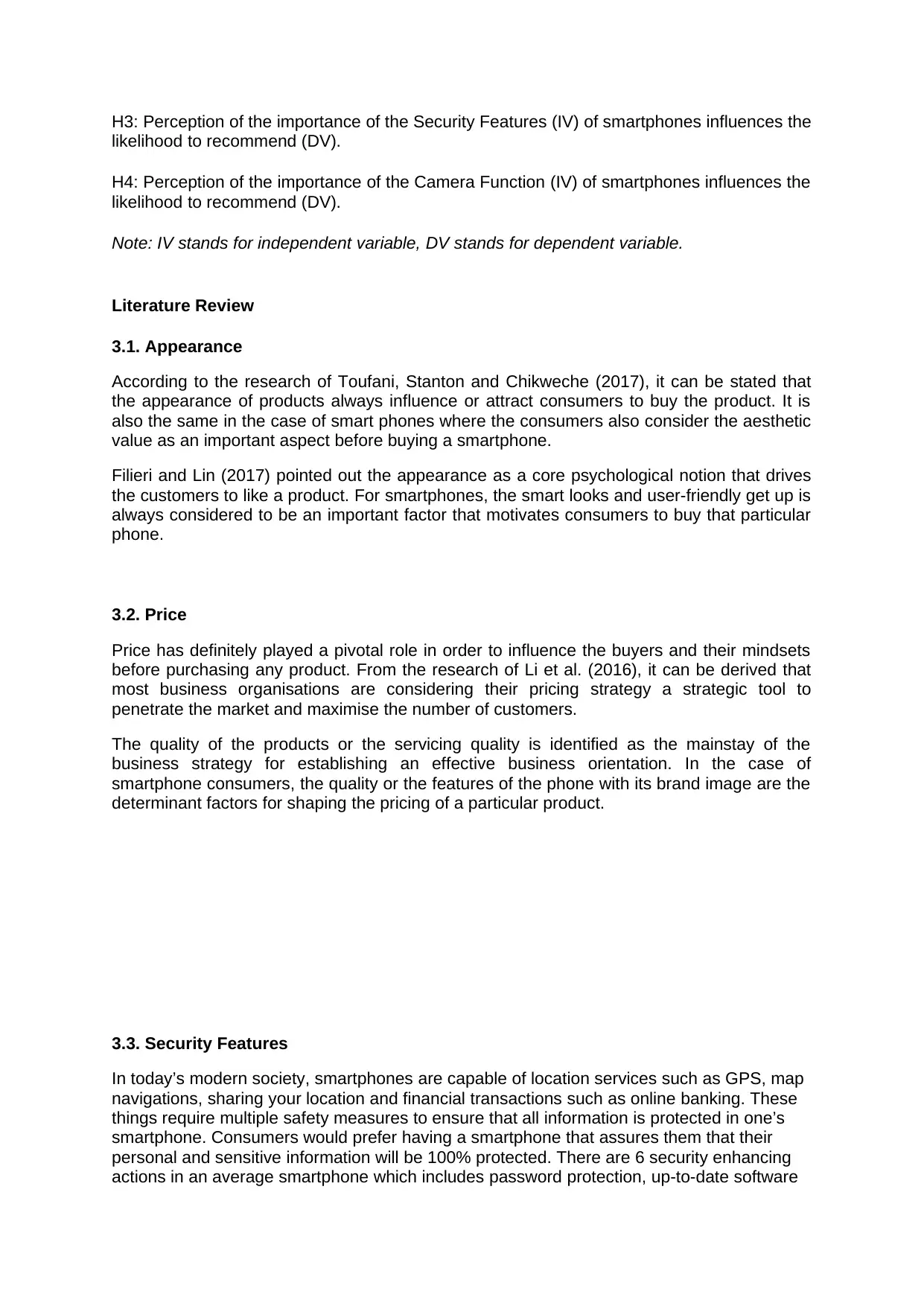
H3: Perception of the importance of the Security Features (IV) of smartphones influences the
likelihood to recommend (DV).
H4: Perception of the importance of the Camera Function (IV) of smartphones influences the
likelihood to recommend (DV).
Note: IV stands for independent variable, DV stands for dependent variable.
Literature Review
3.1. Appearance
According to the research of Toufani, Stanton and Chikweche (2017), it can be stated that
the appearance of products always influence or attract consumers to buy the product. It is
also the same in the case of smart phones where the consumers also consider the aesthetic
value as an important aspect before buying a smartphone.
Filieri and Lin (2017) pointed out the appearance as a core psychological notion that drives
the customers to like a product. For smartphones, the smart looks and user-friendly get up is
always considered to be an important factor that motivates consumers to buy that particular
phone.
3.2. Price
Price has definitely played a pivotal role in order to influence the buyers and their mindsets
before purchasing any product. From the research of Li et al. (2016), it can be derived that
most business organisations are considering their pricing strategy a strategic tool to
penetrate the market and maximise the number of customers.
The quality of the products or the servicing quality is identified as the mainstay of the
business strategy for establishing an effective business orientation. In the case of
smartphone consumers, the quality or the features of the phone with its brand image are the
determinant factors for shaping the pricing of a particular product.
3.3. Security Features
In today’s modern society, smartphones are capable of location services such as GPS, map
navigations, sharing your location and financial transactions such as online banking. These
things require multiple safety measures to ensure that all information is protected in one’s
smartphone. Consumers would prefer having a smartphone that assures them that their
personal and sensitive information will be 100% protected. There are 6 security enhancing
actions in an average smartphone which includes password protection, up-to-date software
likelihood to recommend (DV).
H4: Perception of the importance of the Camera Function (IV) of smartphones influences the
likelihood to recommend (DV).
Note: IV stands for independent variable, DV stands for dependent variable.
Literature Review
3.1. Appearance
According to the research of Toufani, Stanton and Chikweche (2017), it can be stated that
the appearance of products always influence or attract consumers to buy the product. It is
also the same in the case of smart phones where the consumers also consider the aesthetic
value as an important aspect before buying a smartphone.
Filieri and Lin (2017) pointed out the appearance as a core psychological notion that drives
the customers to like a product. For smartphones, the smart looks and user-friendly get up is
always considered to be an important factor that motivates consumers to buy that particular
phone.
3.2. Price
Price has definitely played a pivotal role in order to influence the buyers and their mindsets
before purchasing any product. From the research of Li et al. (2016), it can be derived that
most business organisations are considering their pricing strategy a strategic tool to
penetrate the market and maximise the number of customers.
The quality of the products or the servicing quality is identified as the mainstay of the
business strategy for establishing an effective business orientation. In the case of
smartphone consumers, the quality or the features of the phone with its brand image are the
determinant factors for shaping the pricing of a particular product.
3.3. Security Features
In today’s modern society, smartphones are capable of location services such as GPS, map
navigations, sharing your location and financial transactions such as online banking. These
things require multiple safety measures to ensure that all information is protected in one’s
smartphone. Consumers would prefer having a smartphone that assures them that their
personal and sensitive information will be 100% protected. There are 6 security enhancing
actions in an average smartphone which includes password protection, up-to-date software
⊘ This is a preview!⊘
Do you want full access?
Subscribe today to unlock all pages.

Trusted by 1+ million students worldwide
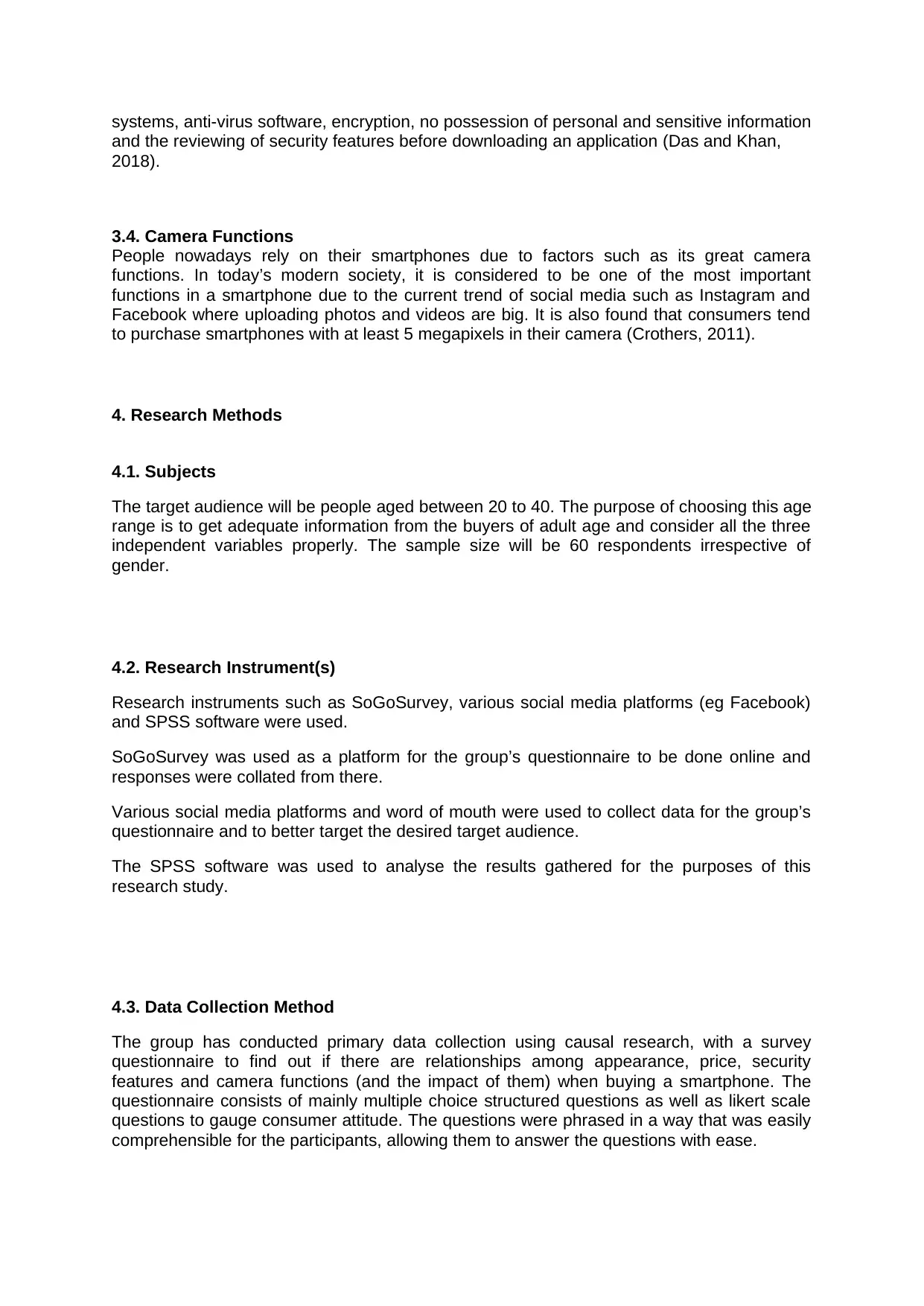
systems, anti-virus software, encryption, no possession of personal and sensitive information
and the reviewing of security features before downloading an application (Das and Khan,
2018).
3.4. Camera Functions
People nowadays rely on their smartphones due to factors such as its great camera
functions. In today’s modern society, it is considered to be one of the most important
functions in a smartphone due to the current trend of social media such as Instagram and
Facebook where uploading photos and videos are big. It is also found that consumers tend
to purchase smartphones with at least 5 megapixels in their camera (Crothers, 2011).
4. Research Methods
4.1. Subjects
The target audience will be people aged between 20 to 40. The purpose of choosing this age
range is to get adequate information from the buyers of adult age and consider all the three
independent variables properly. The sample size will be 60 respondents irrespective of
gender.
4.2. Research Instrument(s)
Research instruments such as SoGoSurvey, various social media platforms (eg Facebook)
and SPSS software were used.
SoGoSurvey was used as a platform for the group’s questionnaire to be done online and
responses were collated from there.
Various social media platforms and word of mouth were used to collect data for the group’s
questionnaire and to better target the desired target audience.
The SPSS software was used to analyse the results gathered for the purposes of this
research study.
4.3. Data Collection Method
The group has conducted primary data collection using causal research, with a survey
questionnaire to find out if there are relationships among appearance, price, security
features and camera functions (and the impact of them) when buying a smartphone. The
questionnaire consists of mainly multiple choice structured questions as well as likert scale
questions to gauge consumer attitude. The questions were phrased in a way that was easily
comprehensible for the participants, allowing them to answer the questions with ease.
and the reviewing of security features before downloading an application (Das and Khan,
2018).
3.4. Camera Functions
People nowadays rely on their smartphones due to factors such as its great camera
functions. In today’s modern society, it is considered to be one of the most important
functions in a smartphone due to the current trend of social media such as Instagram and
Facebook where uploading photos and videos are big. It is also found that consumers tend
to purchase smartphones with at least 5 megapixels in their camera (Crothers, 2011).
4. Research Methods
4.1. Subjects
The target audience will be people aged between 20 to 40. The purpose of choosing this age
range is to get adequate information from the buyers of adult age and consider all the three
independent variables properly. The sample size will be 60 respondents irrespective of
gender.
4.2. Research Instrument(s)
Research instruments such as SoGoSurvey, various social media platforms (eg Facebook)
and SPSS software were used.
SoGoSurvey was used as a platform for the group’s questionnaire to be done online and
responses were collated from there.
Various social media platforms and word of mouth were used to collect data for the group’s
questionnaire and to better target the desired target audience.
The SPSS software was used to analyse the results gathered for the purposes of this
research study.
4.3. Data Collection Method
The group has conducted primary data collection using causal research, with a survey
questionnaire to find out if there are relationships among appearance, price, security
features and camera functions (and the impact of them) when buying a smartphone. The
questionnaire consists of mainly multiple choice structured questions as well as likert scale
questions to gauge consumer attitude. The questions were phrased in a way that was easily
comprehensible for the participants, allowing them to answer the questions with ease.
Paraphrase This Document
Need a fresh take? Get an instant paraphrase of this document with our AI Paraphraser
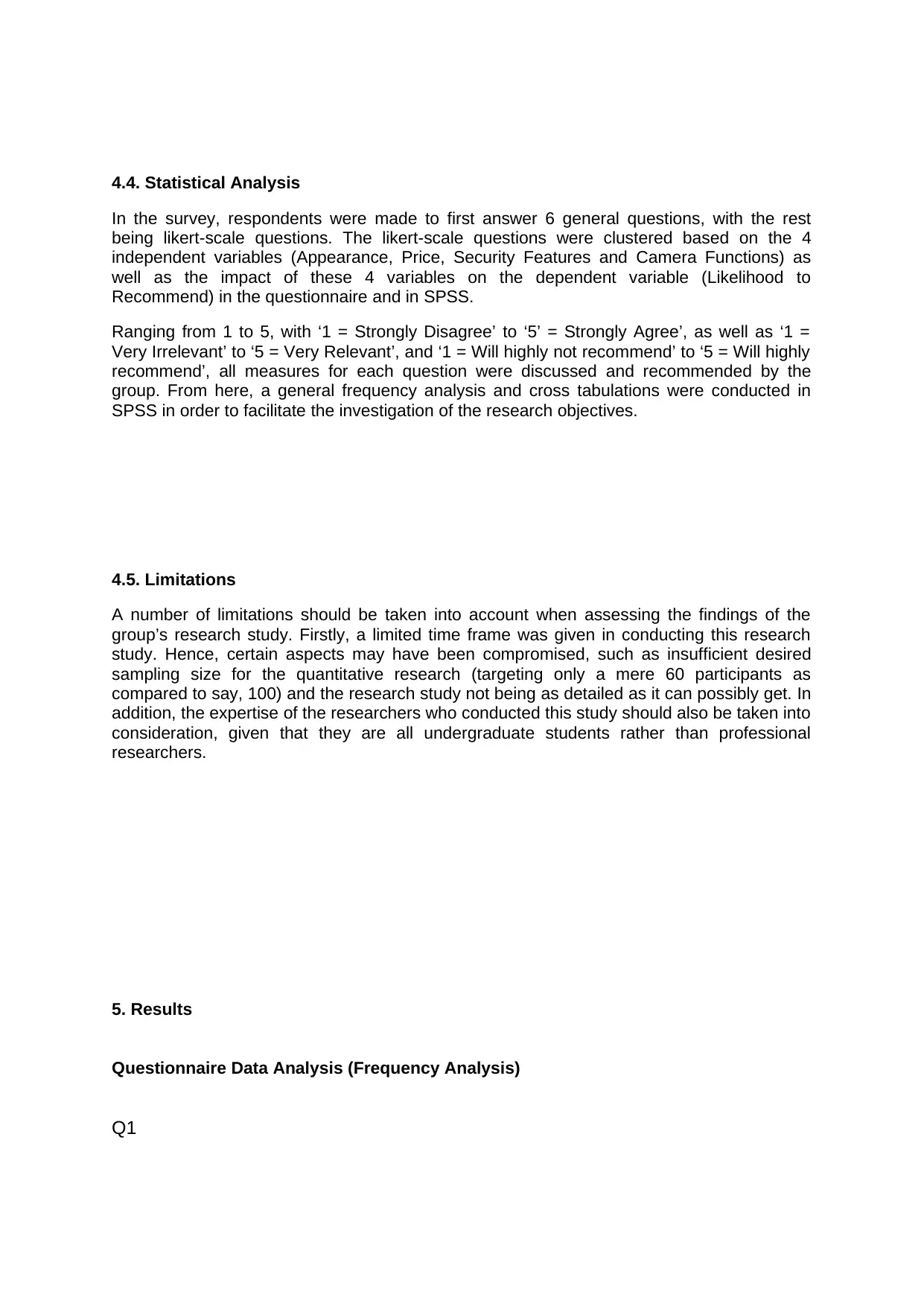
4.4. Statistical Analysis
In the survey, respondents were made to first answer 6 general questions, with the rest
being likert-scale questions. The likert-scale questions were clustered based on the 4
independent variables (Appearance, Price, Security Features and Camera Functions) as
well as the impact of these 4 variables on the dependent variable (Likelihood to
Recommend) in the questionnaire and in SPSS.
Ranging from 1 to 5, with ‘1 = Strongly Disagree’ to ‘5’ = Strongly Agree’, as well as ‘1 =
Very Irrelevant’ to ‘5 = Very Relevant’, and ‘1 = Will highly not recommend’ to ‘5 = Will highly
recommend’, all measures for each question were discussed and recommended by the
group. From here, a general frequency analysis and cross tabulations were conducted in
SPSS in order to facilitate the investigation of the research objectives.
4.5. Limitations
A number of limitations should be taken into account when assessing the findings of the
group’s research study. Firstly, a limited time frame was given in conducting this research
study. Hence, certain aspects may have been compromised, such as insufficient desired
sampling size for the quantitative research (targeting only a mere 60 participants as
compared to say, 100) and the research study not being as detailed as it can possibly get. In
addition, the expertise of the researchers who conducted this study should also be taken into
consideration, given that they are all undergraduate students rather than professional
researchers.
5. Results
Questionnaire Data Analysis (Frequency Analysis)
Q1
In the survey, respondents were made to first answer 6 general questions, with the rest
being likert-scale questions. The likert-scale questions were clustered based on the 4
independent variables (Appearance, Price, Security Features and Camera Functions) as
well as the impact of these 4 variables on the dependent variable (Likelihood to
Recommend) in the questionnaire and in SPSS.
Ranging from 1 to 5, with ‘1 = Strongly Disagree’ to ‘5’ = Strongly Agree’, as well as ‘1 =
Very Irrelevant’ to ‘5 = Very Relevant’, and ‘1 = Will highly not recommend’ to ‘5 = Will highly
recommend’, all measures for each question were discussed and recommended by the
group. From here, a general frequency analysis and cross tabulations were conducted in
SPSS in order to facilitate the investigation of the research objectives.
4.5. Limitations
A number of limitations should be taken into account when assessing the findings of the
group’s research study. Firstly, a limited time frame was given in conducting this research
study. Hence, certain aspects may have been compromised, such as insufficient desired
sampling size for the quantitative research (targeting only a mere 60 participants as
compared to say, 100) and the research study not being as detailed as it can possibly get. In
addition, the expertise of the researchers who conducted this study should also be taken into
consideration, given that they are all undergraduate students rather than professional
researchers.
5. Results
Questionnaire Data Analysis (Frequency Analysis)
Q1
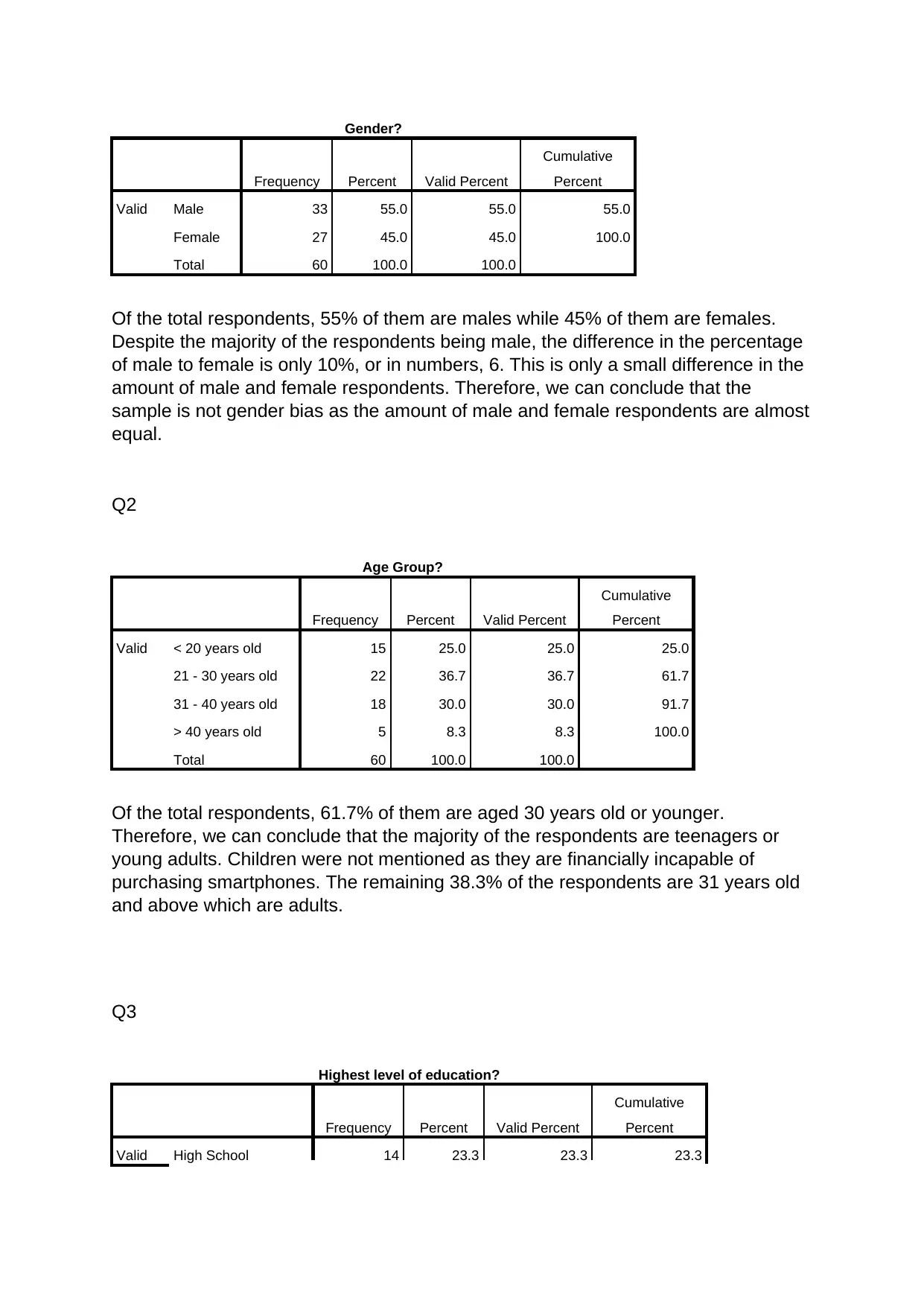
Gender?
Frequency Percent Valid Percent
Cumulative
Percent
Valid Male 33 55.0 55.0 55.0
Female 27 45.0 45.0 100.0
Total 60 100.0 100.0
Of the total respondents, 55% of them are males while 45% of them are females.
Despite the majority of the respondents being male, the difference in the percentage
of male to female is only 10%, or in numbers, 6. This is only a small difference in the
amount of male and female respondents. Therefore, we can conclude that the
sample is not gender bias as the amount of male and female respondents are almost
equal.
Q2
Age Group?
Frequency Percent Valid Percent
Cumulative
Percent
Valid < 20 years old 15 25.0 25.0 25.0
21 - 30 years old 22 36.7 36.7 61.7
31 - 40 years old 18 30.0 30.0 91.7
> 40 years old 5 8.3 8.3 100.0
Total 60 100.0 100.0
Of the total respondents, 61.7% of them are aged 30 years old or younger.
Therefore, we can conclude that the majority of the respondents are teenagers or
young adults. Children were not mentioned as they are financially incapable of
purchasing smartphones. The remaining 38.3% of the respondents are 31 years old
and above which are adults.
Q3
Highest level of education?
Frequency Percent Valid Percent
Cumulative
Percent
Valid High School 14 23.3 23.3 23.3
Frequency Percent Valid Percent
Cumulative
Percent
Valid Male 33 55.0 55.0 55.0
Female 27 45.0 45.0 100.0
Total 60 100.0 100.0
Of the total respondents, 55% of them are males while 45% of them are females.
Despite the majority of the respondents being male, the difference in the percentage
of male to female is only 10%, or in numbers, 6. This is only a small difference in the
amount of male and female respondents. Therefore, we can conclude that the
sample is not gender bias as the amount of male and female respondents are almost
equal.
Q2
Age Group?
Frequency Percent Valid Percent
Cumulative
Percent
Valid < 20 years old 15 25.0 25.0 25.0
21 - 30 years old 22 36.7 36.7 61.7
31 - 40 years old 18 30.0 30.0 91.7
> 40 years old 5 8.3 8.3 100.0
Total 60 100.0 100.0
Of the total respondents, 61.7% of them are aged 30 years old or younger.
Therefore, we can conclude that the majority of the respondents are teenagers or
young adults. Children were not mentioned as they are financially incapable of
purchasing smartphones. The remaining 38.3% of the respondents are 31 years old
and above which are adults.
Q3
Highest level of education?
Frequency Percent Valid Percent
Cumulative
Percent
Valid High School 14 23.3 23.3 23.3
⊘ This is a preview!⊘
Do you want full access?
Subscribe today to unlock all pages.

Trusted by 1+ million students worldwide
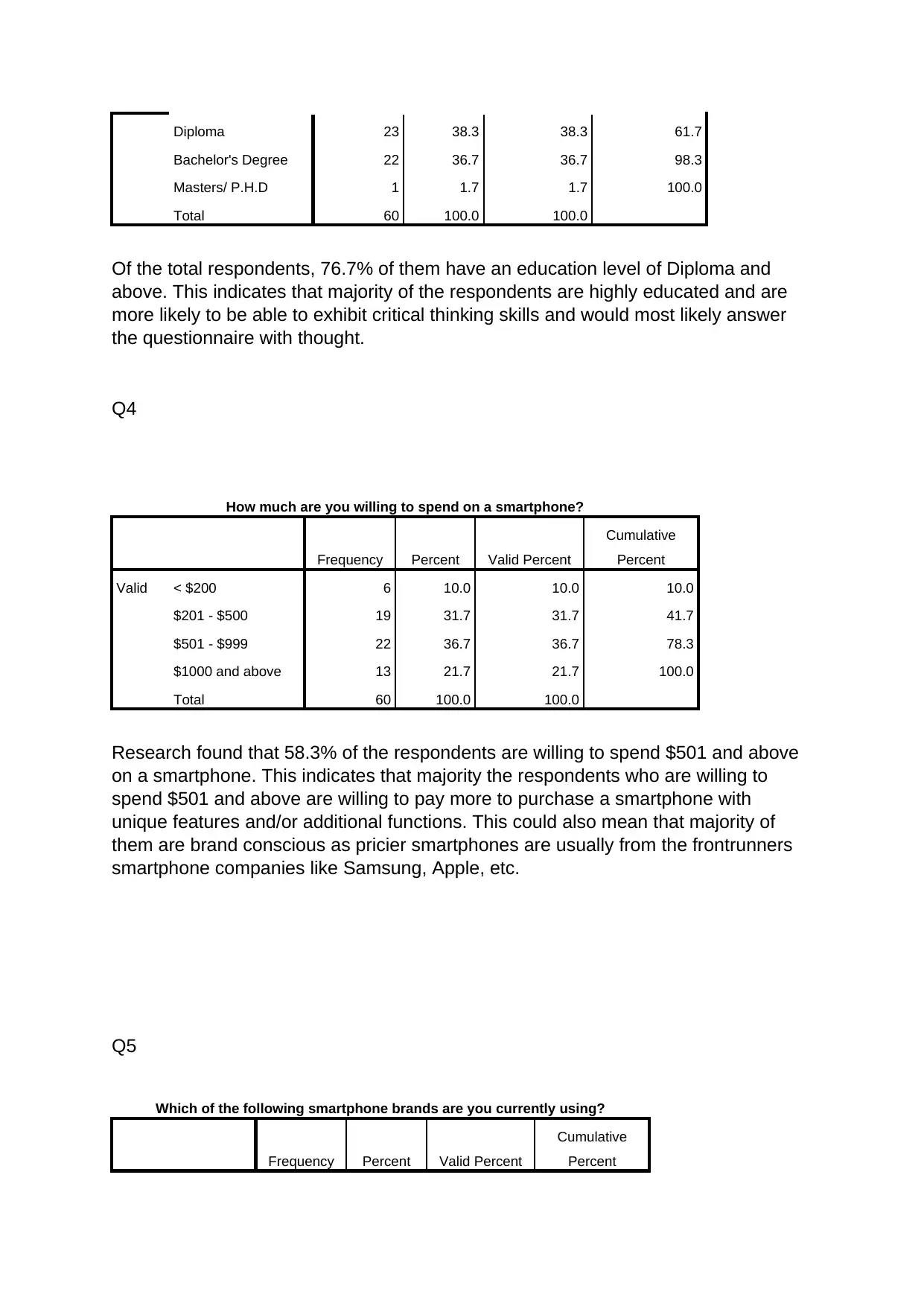
Diploma 23 38.3 38.3 61.7
Bachelor's Degree 22 36.7 36.7 98.3
Masters/ P.H.D 1 1.7 1.7 100.0
Total 60 100.0 100.0
Of the total respondents, 76.7% of them have an education level of Diploma and
above. This indicates that majority of the respondents are highly educated and are
more likely to be able to exhibit critical thinking skills and would most likely answer
the questionnaire with thought.
Q4
How much are you willing to spend on a smartphone?
Frequency Percent Valid Percent
Cumulative
Percent
Valid < $200 6 10.0 10.0 10.0
$201 - $500 19 31.7 31.7 41.7
$501 - $999 22 36.7 36.7 78.3
$1000 and above 13 21.7 21.7 100.0
Total 60 100.0 100.0
Research found that 58.3% of the respondents are willing to spend $501 and above
on a smartphone. This indicates that majority the respondents who are willing to
spend $501 and above are willing to pay more to purchase a smartphone with
unique features and/or additional functions. This could also mean that majority of
them are brand conscious as pricier smartphones are usually from the frontrunners
smartphone companies like Samsung, Apple, etc.
Q5
Which of the following smartphone brands are you currently using?
Frequency Percent Valid Percent
Cumulative
Percent
Bachelor's Degree 22 36.7 36.7 98.3
Masters/ P.H.D 1 1.7 1.7 100.0
Total 60 100.0 100.0
Of the total respondents, 76.7% of them have an education level of Diploma and
above. This indicates that majority of the respondents are highly educated and are
more likely to be able to exhibit critical thinking skills and would most likely answer
the questionnaire with thought.
Q4
How much are you willing to spend on a smartphone?
Frequency Percent Valid Percent
Cumulative
Percent
Valid < $200 6 10.0 10.0 10.0
$201 - $500 19 31.7 31.7 41.7
$501 - $999 22 36.7 36.7 78.3
$1000 and above 13 21.7 21.7 100.0
Total 60 100.0 100.0
Research found that 58.3% of the respondents are willing to spend $501 and above
on a smartphone. This indicates that majority the respondents who are willing to
spend $501 and above are willing to pay more to purchase a smartphone with
unique features and/or additional functions. This could also mean that majority of
them are brand conscious as pricier smartphones are usually from the frontrunners
smartphone companies like Samsung, Apple, etc.
Q5
Which of the following smartphone brands are you currently using?
Frequency Percent Valid Percent
Cumulative
Percent
Paraphrase This Document
Need a fresh take? Get an instant paraphrase of this document with our AI Paraphraser
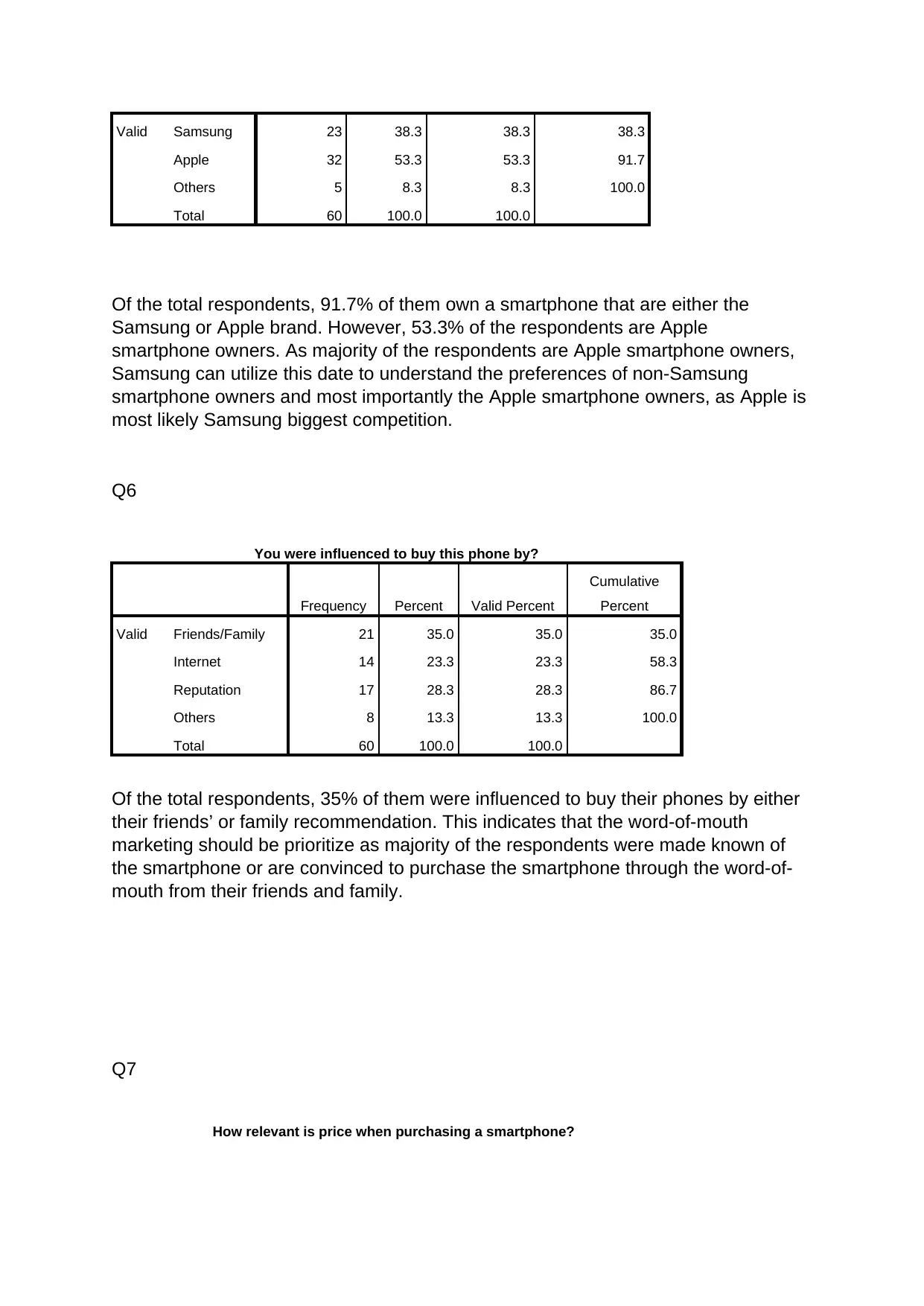
Valid Samsung 23 38.3 38.3 38.3
Apple 32 53.3 53.3 91.7
Others 5 8.3 8.3 100.0
Total 60 100.0 100.0
Of the total respondents, 91.7% of them own a smartphone that are either the
Samsung or Apple brand. However, 53.3% of the respondents are Apple
smartphone owners. As majority of the respondents are Apple smartphone owners,
Samsung can utilize this date to understand the preferences of non-Samsung
smartphone owners and most importantly the Apple smartphone owners, as Apple is
most likely Samsung biggest competition.
Q6
You were influenced to buy this phone by?
Frequency Percent Valid Percent
Cumulative
Percent
Valid Friends/Family 21 35.0 35.0 35.0
Internet 14 23.3 23.3 58.3
Reputation 17 28.3 28.3 86.7
Others 8 13.3 13.3 100.0
Total 60 100.0 100.0
Of the total respondents, 35% of them were influenced to buy their phones by either
their friends’ or family recommendation. This indicates that the word-of-mouth
marketing should be prioritize as majority of the respondents were made known of
the smartphone or are convinced to purchase the smartphone through the word-of-
mouth from their friends and family.
Q7
How relevant is price when purchasing a smartphone?
Apple 32 53.3 53.3 91.7
Others 5 8.3 8.3 100.0
Total 60 100.0 100.0
Of the total respondents, 91.7% of them own a smartphone that are either the
Samsung or Apple brand. However, 53.3% of the respondents are Apple
smartphone owners. As majority of the respondents are Apple smartphone owners,
Samsung can utilize this date to understand the preferences of non-Samsung
smartphone owners and most importantly the Apple smartphone owners, as Apple is
most likely Samsung biggest competition.
Q6
You were influenced to buy this phone by?
Frequency Percent Valid Percent
Cumulative
Percent
Valid Friends/Family 21 35.0 35.0 35.0
Internet 14 23.3 23.3 58.3
Reputation 17 28.3 28.3 86.7
Others 8 13.3 13.3 100.0
Total 60 100.0 100.0
Of the total respondents, 35% of them were influenced to buy their phones by either
their friends’ or family recommendation. This indicates that the word-of-mouth
marketing should be prioritize as majority of the respondents were made known of
the smartphone or are convinced to purchase the smartphone through the word-of-
mouth from their friends and family.
Q7
How relevant is price when purchasing a smartphone?
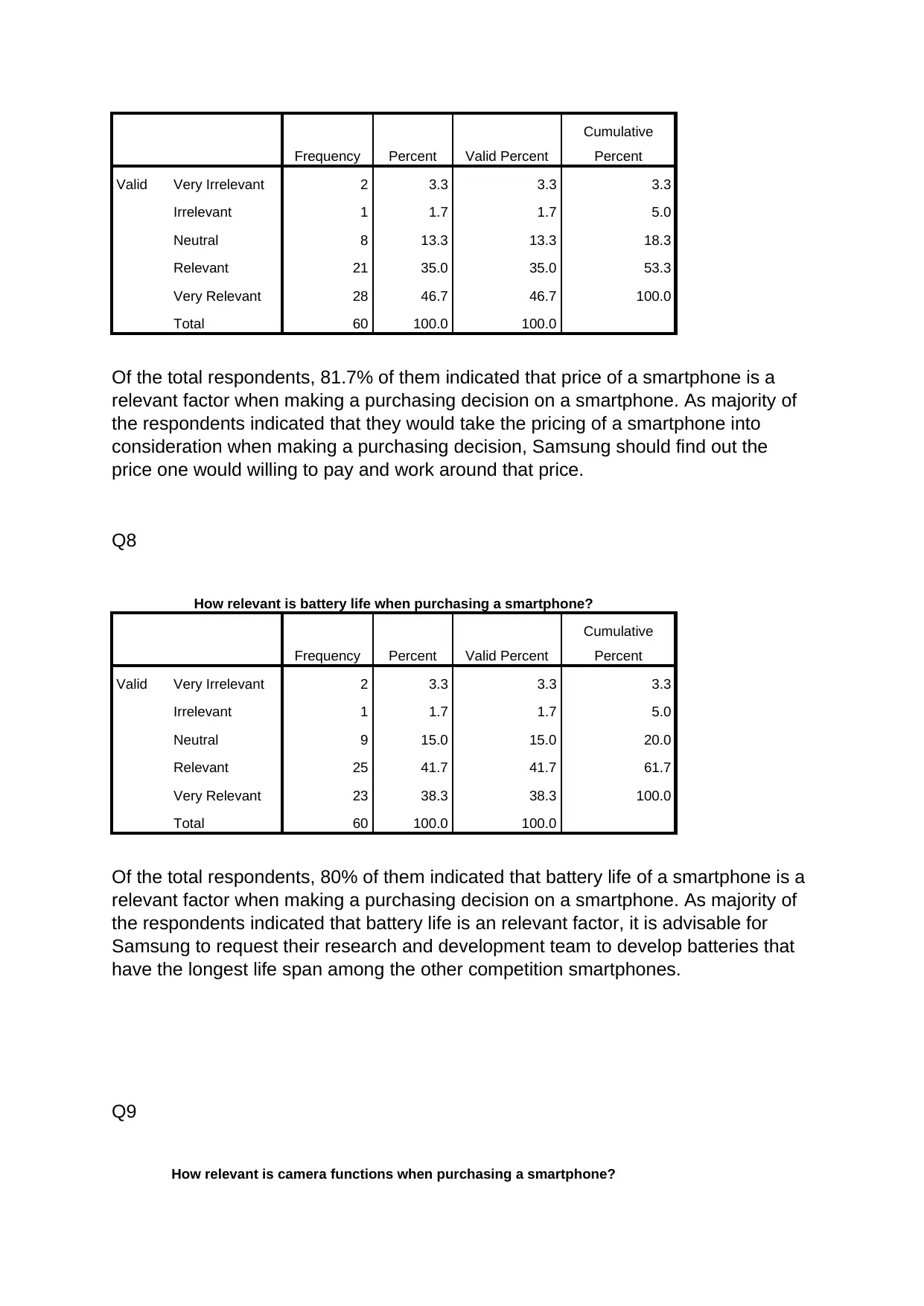
Frequency Percent Valid Percent
Cumulative
Percent
Valid Very Irrelevant 2 3.3 3.3 3.3
Irrelevant 1 1.7 1.7 5.0
Neutral 8 13.3 13.3 18.3
Relevant 21 35.0 35.0 53.3
Very Relevant 28 46.7 46.7 100.0
Total 60 100.0 100.0
Of the total respondents, 81.7% of them indicated that price of a smartphone is a
relevant factor when making a purchasing decision on a smartphone. As majority of
the respondents indicated that they would take the pricing of a smartphone into
consideration when making a purchasing decision, Samsung should find out the
price one would willing to pay and work around that price.
Q8
How relevant is battery life when purchasing a smartphone?
Frequency Percent Valid Percent
Cumulative
Percent
Valid Very Irrelevant 2 3.3 3.3 3.3
Irrelevant 1 1.7 1.7 5.0
Neutral 9 15.0 15.0 20.0
Relevant 25 41.7 41.7 61.7
Very Relevant 23 38.3 38.3 100.0
Total 60 100.0 100.0
Of the total respondents, 80% of them indicated that battery life of a smartphone is a
relevant factor when making a purchasing decision on a smartphone. As majority of
the respondents indicated that battery life is an relevant factor, it is advisable for
Samsung to request their research and development team to develop batteries that
have the longest life span among the other competition smartphones.
Q9
How relevant is camera functions when purchasing a smartphone?
Cumulative
Percent
Valid Very Irrelevant 2 3.3 3.3 3.3
Irrelevant 1 1.7 1.7 5.0
Neutral 8 13.3 13.3 18.3
Relevant 21 35.0 35.0 53.3
Very Relevant 28 46.7 46.7 100.0
Total 60 100.0 100.0
Of the total respondents, 81.7% of them indicated that price of a smartphone is a
relevant factor when making a purchasing decision on a smartphone. As majority of
the respondents indicated that they would take the pricing of a smartphone into
consideration when making a purchasing decision, Samsung should find out the
price one would willing to pay and work around that price.
Q8
How relevant is battery life when purchasing a smartphone?
Frequency Percent Valid Percent
Cumulative
Percent
Valid Very Irrelevant 2 3.3 3.3 3.3
Irrelevant 1 1.7 1.7 5.0
Neutral 9 15.0 15.0 20.0
Relevant 25 41.7 41.7 61.7
Very Relevant 23 38.3 38.3 100.0
Total 60 100.0 100.0
Of the total respondents, 80% of them indicated that battery life of a smartphone is a
relevant factor when making a purchasing decision on a smartphone. As majority of
the respondents indicated that battery life is an relevant factor, it is advisable for
Samsung to request their research and development team to develop batteries that
have the longest life span among the other competition smartphones.
Q9
How relevant is camera functions when purchasing a smartphone?
⊘ This is a preview!⊘
Do you want full access?
Subscribe today to unlock all pages.

Trusted by 1+ million students worldwide
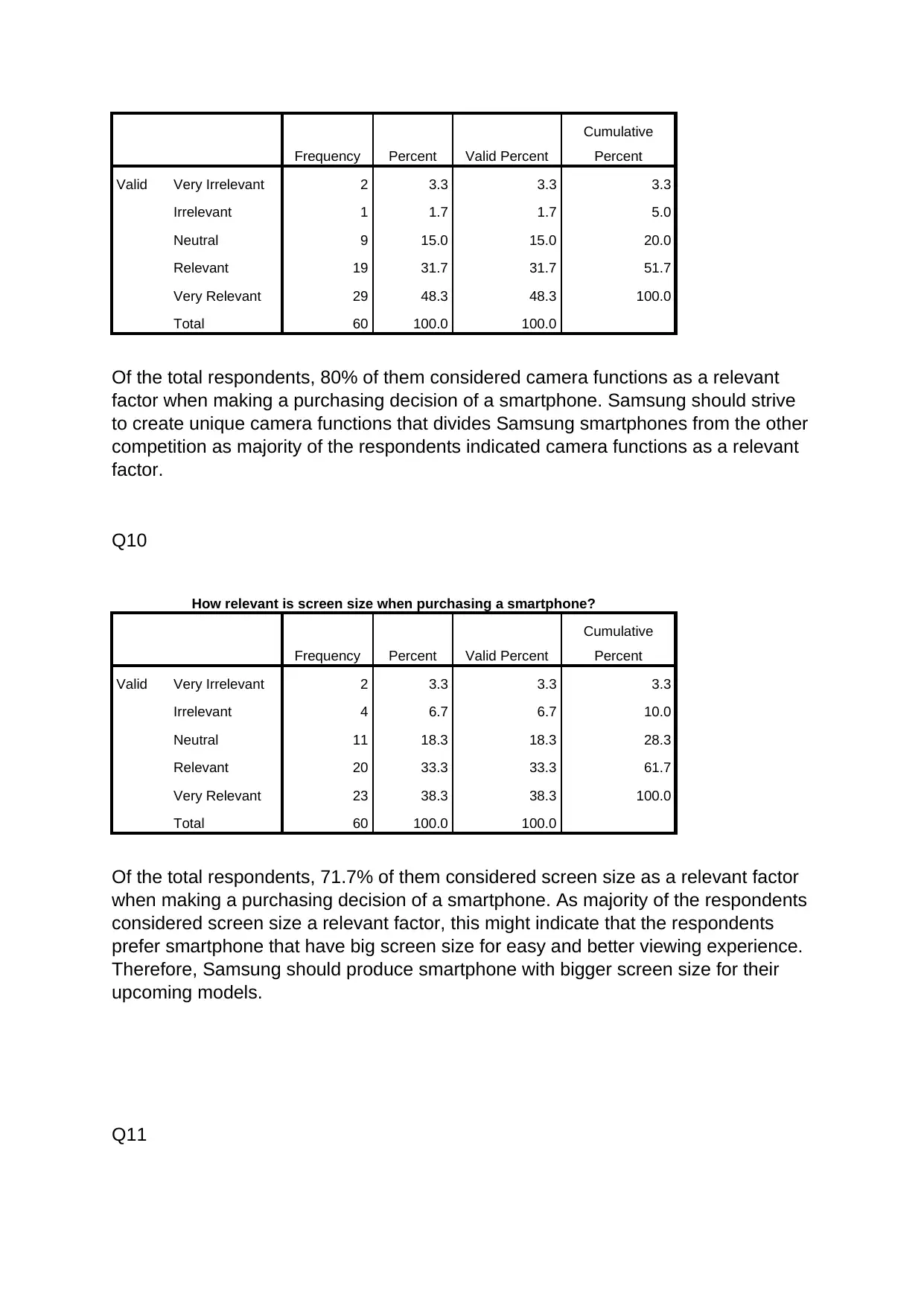
Frequency Percent Valid Percent
Cumulative
Percent
Valid Very Irrelevant 2 3.3 3.3 3.3
Irrelevant 1 1.7 1.7 5.0
Neutral 9 15.0 15.0 20.0
Relevant 19 31.7 31.7 51.7
Very Relevant 29 48.3 48.3 100.0
Total 60 100.0 100.0
Of the total respondents, 80% of them considered camera functions as a relevant
factor when making a purchasing decision of a smartphone. Samsung should strive
to create unique camera functions that divides Samsung smartphones from the other
competition as majority of the respondents indicated camera functions as a relevant
factor.
Q10
How relevant is screen size when purchasing a smartphone?
Frequency Percent Valid Percent
Cumulative
Percent
Valid Very Irrelevant 2 3.3 3.3 3.3
Irrelevant 4 6.7 6.7 10.0
Neutral 11 18.3 18.3 28.3
Relevant 20 33.3 33.3 61.7
Very Relevant 23 38.3 38.3 100.0
Total 60 100.0 100.0
Of the total respondents, 71.7% of them considered screen size as a relevant factor
when making a purchasing decision of a smartphone. As majority of the respondents
considered screen size a relevant factor, this might indicate that the respondents
prefer smartphone that have big screen size for easy and better viewing experience.
Therefore, Samsung should produce smartphone with bigger screen size for their
upcoming models.
Q11
Cumulative
Percent
Valid Very Irrelevant 2 3.3 3.3 3.3
Irrelevant 1 1.7 1.7 5.0
Neutral 9 15.0 15.0 20.0
Relevant 19 31.7 31.7 51.7
Very Relevant 29 48.3 48.3 100.0
Total 60 100.0 100.0
Of the total respondents, 80% of them considered camera functions as a relevant
factor when making a purchasing decision of a smartphone. Samsung should strive
to create unique camera functions that divides Samsung smartphones from the other
competition as majority of the respondents indicated camera functions as a relevant
factor.
Q10
How relevant is screen size when purchasing a smartphone?
Frequency Percent Valid Percent
Cumulative
Percent
Valid Very Irrelevant 2 3.3 3.3 3.3
Irrelevant 4 6.7 6.7 10.0
Neutral 11 18.3 18.3 28.3
Relevant 20 33.3 33.3 61.7
Very Relevant 23 38.3 38.3 100.0
Total 60 100.0 100.0
Of the total respondents, 71.7% of them considered screen size as a relevant factor
when making a purchasing decision of a smartphone. As majority of the respondents
considered screen size a relevant factor, this might indicate that the respondents
prefer smartphone that have big screen size for easy and better viewing experience.
Therefore, Samsung should produce smartphone with bigger screen size for their
upcoming models.
Q11
Paraphrase This Document
Need a fresh take? Get an instant paraphrase of this document with our AI Paraphraser
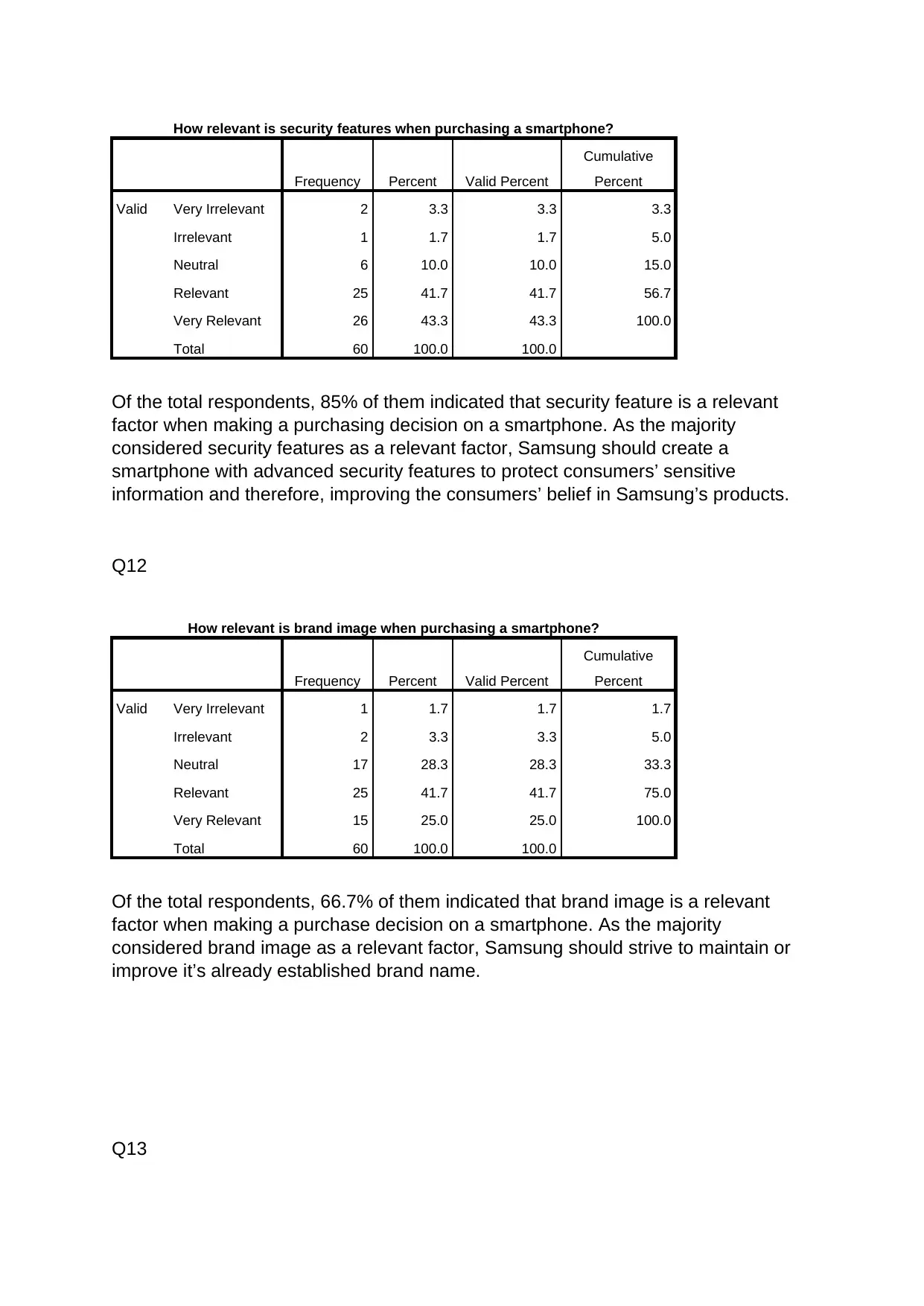
How relevant is security features when purchasing a smartphone?
Frequency Percent Valid Percent
Cumulative
Percent
Valid Very Irrelevant 2 3.3 3.3 3.3
Irrelevant 1 1.7 1.7 5.0
Neutral 6 10.0 10.0 15.0
Relevant 25 41.7 41.7 56.7
Very Relevant 26 43.3 43.3 100.0
Total 60 100.0 100.0
Of the total respondents, 85% of them indicated that security feature is a relevant
factor when making a purchasing decision on a smartphone. As the majority
considered security features as a relevant factor, Samsung should create a
smartphone with advanced security features to protect consumers’ sensitive
information and therefore, improving the consumers’ belief in Samsung’s products.
Q12
How relevant is brand image when purchasing a smartphone?
Frequency Percent Valid Percent
Cumulative
Percent
Valid Very Irrelevant 1 1.7 1.7 1.7
Irrelevant 2 3.3 3.3 5.0
Neutral 17 28.3 28.3 33.3
Relevant 25 41.7 41.7 75.0
Very Relevant 15 25.0 25.0 100.0
Total 60 100.0 100.0
Of the total respondents, 66.7% of them indicated that brand image is a relevant
factor when making a purchase decision on a smartphone. As the majority
considered brand image as a relevant factor, Samsung should strive to maintain or
improve it’s already established brand name.
Q13
Frequency Percent Valid Percent
Cumulative
Percent
Valid Very Irrelevant 2 3.3 3.3 3.3
Irrelevant 1 1.7 1.7 5.0
Neutral 6 10.0 10.0 15.0
Relevant 25 41.7 41.7 56.7
Very Relevant 26 43.3 43.3 100.0
Total 60 100.0 100.0
Of the total respondents, 85% of them indicated that security feature is a relevant
factor when making a purchasing decision on a smartphone. As the majority
considered security features as a relevant factor, Samsung should create a
smartphone with advanced security features to protect consumers’ sensitive
information and therefore, improving the consumers’ belief in Samsung’s products.
Q12
How relevant is brand image when purchasing a smartphone?
Frequency Percent Valid Percent
Cumulative
Percent
Valid Very Irrelevant 1 1.7 1.7 1.7
Irrelevant 2 3.3 3.3 5.0
Neutral 17 28.3 28.3 33.3
Relevant 25 41.7 41.7 75.0
Very Relevant 15 25.0 25.0 100.0
Total 60 100.0 100.0
Of the total respondents, 66.7% of them indicated that brand image is a relevant
factor when making a purchase decision on a smartphone. As the majority
considered brand image as a relevant factor, Samsung should strive to maintain or
improve it’s already established brand name.
Q13
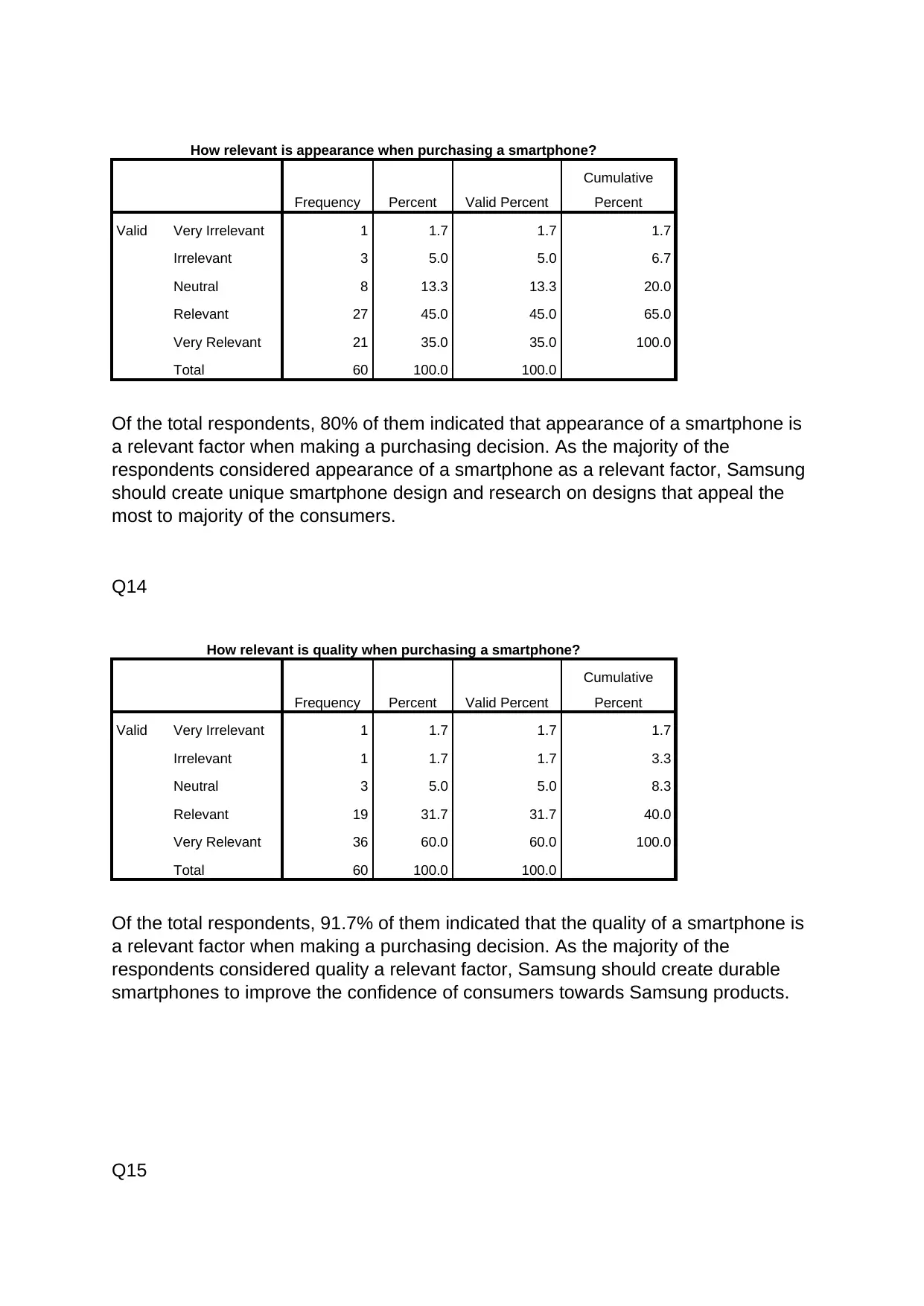
How relevant is appearance when purchasing a smartphone?
Frequency Percent Valid Percent
Cumulative
Percent
Valid Very Irrelevant 1 1.7 1.7 1.7
Irrelevant 3 5.0 5.0 6.7
Neutral 8 13.3 13.3 20.0
Relevant 27 45.0 45.0 65.0
Very Relevant 21 35.0 35.0 100.0
Total 60 100.0 100.0
Of the total respondents, 80% of them indicated that appearance of a smartphone is
a relevant factor when making a purchasing decision. As the majority of the
respondents considered appearance of a smartphone as a relevant factor, Samsung
should create unique smartphone design and research on designs that appeal the
most to majority of the consumers.
Q14
How relevant is quality when purchasing a smartphone?
Frequency Percent Valid Percent
Cumulative
Percent
Valid Very Irrelevant 1 1.7 1.7 1.7
Irrelevant 1 1.7 1.7 3.3
Neutral 3 5.0 5.0 8.3
Relevant 19 31.7 31.7 40.0
Very Relevant 36 60.0 60.0 100.0
Total 60 100.0 100.0
Of the total respondents, 91.7% of them indicated that the quality of a smartphone is
a relevant factor when making a purchasing decision. As the majority of the
respondents considered quality a relevant factor, Samsung should create durable
smartphones to improve the confidence of consumers towards Samsung products.
Q15
Frequency Percent Valid Percent
Cumulative
Percent
Valid Very Irrelevant 1 1.7 1.7 1.7
Irrelevant 3 5.0 5.0 6.7
Neutral 8 13.3 13.3 20.0
Relevant 27 45.0 45.0 65.0
Very Relevant 21 35.0 35.0 100.0
Total 60 100.0 100.0
Of the total respondents, 80% of them indicated that appearance of a smartphone is
a relevant factor when making a purchasing decision. As the majority of the
respondents considered appearance of a smartphone as a relevant factor, Samsung
should create unique smartphone design and research on designs that appeal the
most to majority of the consumers.
Q14
How relevant is quality when purchasing a smartphone?
Frequency Percent Valid Percent
Cumulative
Percent
Valid Very Irrelevant 1 1.7 1.7 1.7
Irrelevant 1 1.7 1.7 3.3
Neutral 3 5.0 5.0 8.3
Relevant 19 31.7 31.7 40.0
Very Relevant 36 60.0 60.0 100.0
Total 60 100.0 100.0
Of the total respondents, 91.7% of them indicated that the quality of a smartphone is
a relevant factor when making a purchasing decision. As the majority of the
respondents considered quality a relevant factor, Samsung should create durable
smartphones to improve the confidence of consumers towards Samsung products.
Q15
⊘ This is a preview!⊘
Do you want full access?
Subscribe today to unlock all pages.

Trusted by 1+ million students worldwide
1 out of 33
Your All-in-One AI-Powered Toolkit for Academic Success.
+13062052269
info@desklib.com
Available 24*7 on WhatsApp / Email
![[object Object]](/_next/static/media/star-bottom.7253800d.svg)
Unlock your academic potential
Copyright © 2020–2025 A2Z Services. All Rights Reserved. Developed and managed by ZUCOL.